2017 MERCEDES-BENZ S-CLASS CABRIOLET warning
[x] Cancel search: warningPage 158 of 521
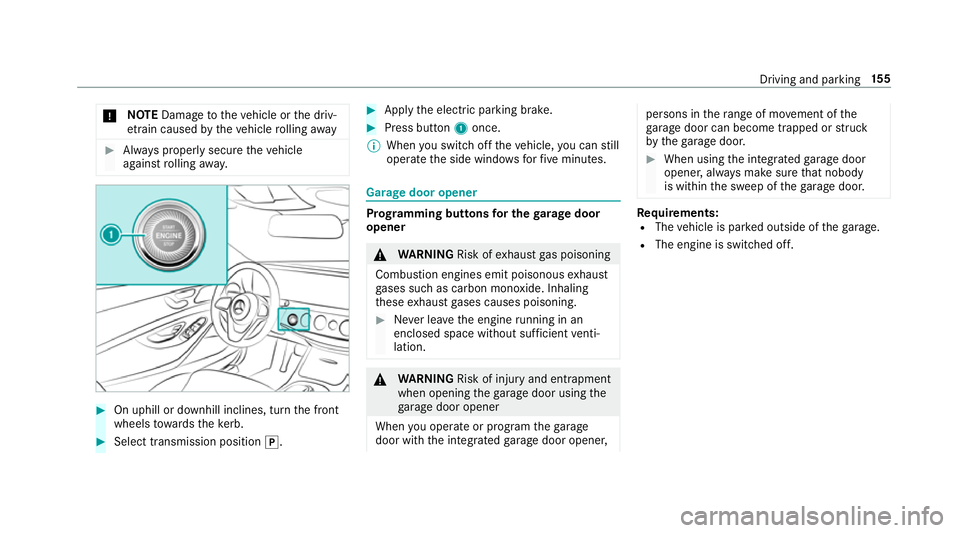
*
NO
TEDama getothev ehicle or thed riv‐
et ra in caused bythev ehicle rolling away #
Alw aysp roper lysecur ethe vehicle
agains trolling away. #
On uphillord ownhill inclines, tur nthe front
wheels towa rdst he kerb. #
Select transmission position j. #
Appl ythe electric parking brake. #
Press button 1once.
% When yous wit ch offt he vehicle, youc an still
opera tethes ide windo wsforf ivem inutes. Garag
edoor opener Prog
rammin gbutton sfor th egarag edoor
opener &
WARNING Risk ofexhaus tgas poisoning
Combustio nengines emit poisonous exhaust
ga ses suc hascarbon monoxide. Inhaling
th ese exhaus tgases causes poisoning. #
Neverlea ve thee ngine running in an
enclose dspace wi thout suf ficient venti‐
lation. &
WARNING Risk of inju ryand ent rapment
when openin gthe garage door using the
ga rage door opener
When youo perat eorp rogram theg arage
door wit hthe integrated garage door opener, persons in
ther ang eofm ovement of the
ga rage door can become trapped or stru ck
by theg arag edoor. #
When using thei ntegrated garage door
opener ,alway sm akes uret hat nobody
is within thes weep of theg arag edoor. Re
quirements:
R The vehicle is par kedo utside of theg arage.
R The engine is swit ched off. Driving and parking
15 5
Page 162 of 521
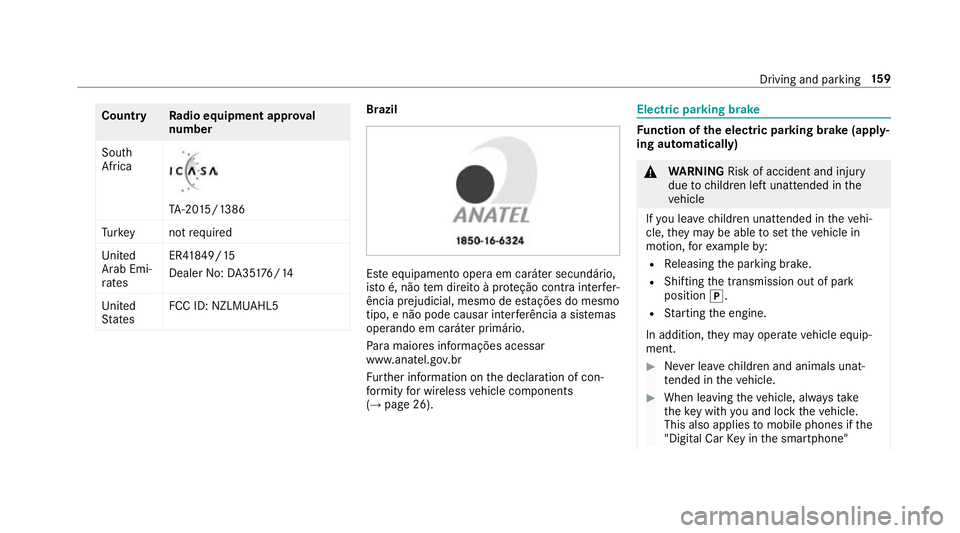
Count
ryRadio equipment appr oval
number
South
Africa TA
-20 15/1386
Tu rkey notrequired
Uni ted
Arab Emi‐
ra tes ER4
1849/15
Dealer No: DA35176/14
United
St ates FCC ID
:NZLM UAHL5 Brazil
Es
te equipament ooper aemc aráter secundário,
is to é, não temd ireit oàp roteção contr ainter fer‐
ência prejudicial ,mesmo de es tações do mesmo
tipo ,en ão pod ecausar inter ferê ncia asiste mas
operando em caráter primário.
Pa ra maio resi nformações acessar
www.anatel.go v.br
Fu rther information on thed eclaration of con‐
fo rm ity forw ireles svehicle components
(→ pag e26). Electric parking brake
Fu
nction of thee lectric pa rking brak e(app ly‐
ing automatically) &
WARNING Risk of accident and inju ry
due tochildren lef tunat tende dint he
ve hicle
If yo ul eave children unat tende dint hevehi‐
cle, they ma ybea bletos etthev ehicle in
motion, fore xamp leby:
R Releasing thep arking brake.
R Shifting thet ransmission out of park
position j.
R Startin gthe engine.
In addition, they ma yoperat evehicle equip‐
ment. #
Neverlea ve children and animals unat‐
te nde dint hevehicle. #
When leaving thev ehicle, alw ayst ake
th ek eywit hyou and loc kthe vehicle.
This also applies tomobil ephones if the
"Digital Car Keyint he smartphone" Driving and parking
15 9
Page 167 of 521
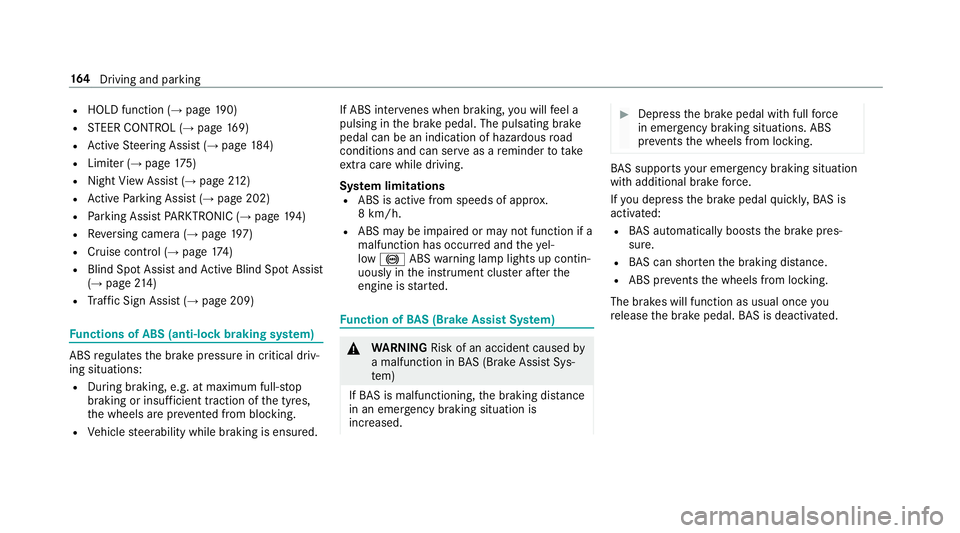
R
HOLD functio n(→ page 190)
R STEER CONTROL (→ page 169)
R ActiveS teering Assis t(→ pag e184)
R Limi ter( →pag e175)
R Nigh tViewA ssist ( →pag e212 )
R ActiveP arking Assis t(→ pag e202)
R Parking Assis tPARKTRONIC (→ page 194)
R Reversing camer a(→pag e197)
R Cruis econtrol (→ page 174)
R Blind Spo tAssis tand ActiveB lind Spo tAssist
( → pag e214 )
R Traf ficS ign Assi st (→pag e209) Fu
nctions of ABS (anti-loc kbraking sy stem) AB
Sr egulates theb rake pressur eincritical driv‐
ing situations:
R During braking, e.g. at maximum full-s top
braking or insuf ficient traction of thet yres,
th ew heels ar epreve nted from blocking.
R Vehicle steerability while braking is ensured. If ABS inter
venes when braking, youw illfeel a
pulsing in theb rake pedal. The pulsating brake
pedal can be an indication of hazardous road
condition sand can ser veas areminder totake
ex trac arew hile driving.
Sy stem limitations
R ABSisa ctivefroms peeds of appr ox.
8k m/h.
R ABS ma ybeimpaire dorm aynotfunction if a
malfunction has occur reda nd they el‐
low ! ABSwarning lam plight supc ontin‐
uousl yinthe instrument clus tera fter the
engine is star ted. Fu
nction of BAS(Brak eAssis tSystem) &
WARNING Risk of an accident caused by
am alfunctio ninBAS (Brak eAssistSys‐
te m)
If BA Sism alfunctioning ,the braking dis tance
in an eme rgency braking situation is
increased. #
Depress theb rake pedal wit hfull force
in emer gency braking situations. ABS
pr eve nts thew heels from locking. BA
Ss uppo rtsy our emer gency braking situation
wit ha dditional brak eforce.
If yo ud epress theb rake pedal quickl y,BA Sis
acti vated:
R BASa utomatically boosts theb rake pres‐
sure.
R BASc an sho rten theb raking dis tance.
R ABS pr events thew heels from locking.
The brakes will function as usual oncey ou
re lease theb rake pedal. BASisd eactivated. 16 4
Driving and pa rking
Page 168 of 521
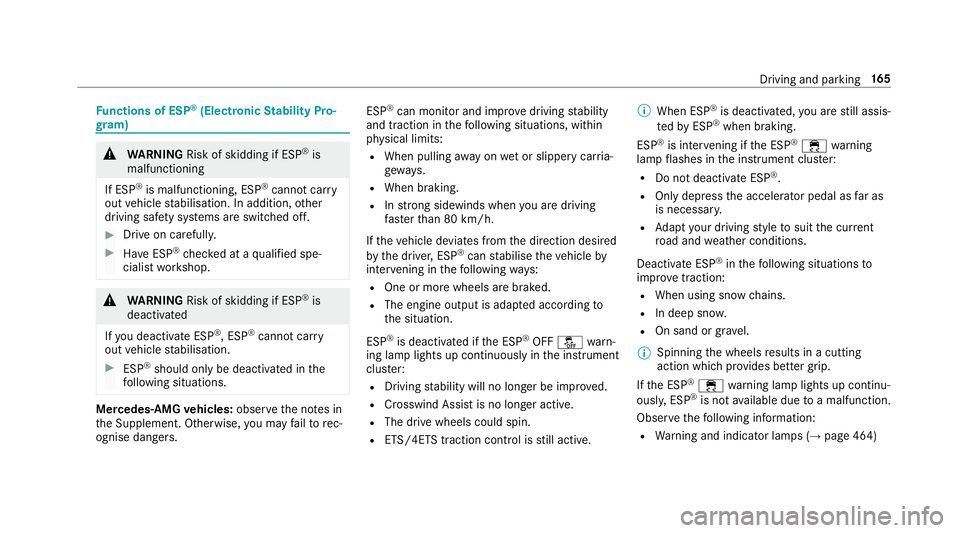
Fu
nctions of ESP ®
(Electronic Stability Pro‐
gr am) &
WARNING Risk of skidding if ESP ®
is
malfunctioning
If ESP ®
is malfunctioning ,ESP ®
canno tcarry
out vehicle stabilisation .Inaddition ,other
driving saf etys ystems ar eswitched off. #
Driv eonc arefull y. #
Have ESP ®
ch eckedataq ualified spe‐
cialis tworks hop. &
WARNING Risk of skidding if ESP ®
is
deactivated
If yo ud eactivat eESP®
,E SP ®
canno tcarry
out vehicle stabilisation. #
ESP ®
shoul donly be deacti vatedint he
fo llowing situations. Mercedes‑AM
Gvehicles: observethen otes in
th eS upplement .Otherwise, youm ayfailto rec‐
ognise dangers. ESP
®
can moni tora nd impr ovedriving stability
and traction in thef ollowing situations, within
ph ysical limits:
R When pulling away on wetors lipper ycarria‐
ge wa ys.
R When braking.
R Instro ng sidewinds when youa redriving
fast erthan 80 km/h.
If th ev ehicle deviates from thed irection desired
by thed rive r,ESP ®
can stabilise thev ehicle by
inter vening in thef ollowing ways:
R One or mor ewheels ar ebrake d.
R The engine output is adap teda ccording to
th es ituation.
ESP ®
is deactivated if theE SP®
OFF å warn‐
ing lam plight supc ontinuousl yinthe instrument
clus ter:
R Driving stabilit ywill no lon gerbei mprove d.
R Crosswind Assis tisnolonger active.
R The driv ewheels could spin.
R ETS/4ET Straction control is still active. %
When ESP ®
is deactivated, youa restill assis‐
te dbyE SP®
when braking.
ESP ®
is inter vening if theE SP®
÷ warning
lam pflashes in thei nstrument clus ter:
R Do no tdeacti vate ESP ®
.
R Only depress thea ccelera torp eda lasf ar as
is necessar y.
R Adapty our driving styletos uitthec urrent
ro ad and weather conditions.
Deactivat eESP®
in thef ollowing situations to
impr ovetraction:
R When using sno wchains.
R In deep sno w.
R On sand or gr avel.
% Spinning thew heels results in acutting
action whic hprovide sbette rg rip.
If th eE SP®
÷ warning lam plight supc ontinu‐
ousl y,ESP ®
is no tavailable due toam alfunction.
Obse rvet he following information:
R Warning and indicator lamps (→ page464) Drivin
gand parking 16 5
Page 170 of 521

Ac
tivating/deactivatin gESP®
(Electronic Sta‐
bility Prog ram) Multimedia sy
stem:
, Vehicle .
k Assistance .
ESP
Mercedes‑AMG vehicles: observet he no tesin
th eS upplement .Otherwise, youm ayfailto rec‐
ognise dangers. #
Activate Oor deacti vate ª thef unction.
ESP ®
is deactivated if theå ESP®
OFF warn‐
ing lam plight supc ontinuousl yinthe instrument
clus ter.
Obser vethei nformation on warning lamps and
displa ymessages whic hmaybe shown in the
instrumen tclus ter. Fu
nctions of ESP ®
Crosswind Assist ESP
®
Crosswind Assis tdetects sudden gusts of
side wind and helps thed rive rtok eepthev ehi‐
cle in thel ane:
R ESP ®
Crosswind Assis tisactiveatv ehicle
speeds between 80 km/h and 200 km/h when driving
stra ight ahead or cornering
slight ly.
R The vehicle is stabilise dbym eans of individ‐
ualb rake application on one side. Fu
nction of EBD (Electronic Brak eforce Dis‐
tribution) EB
Disc haracterised bythef ollowing:
R Monitoring and regulating theb rake pressure
on ther ear wheels.
R Impr oveddriving stabilit ywhen braking,
especiall yonb ends. ST
EER CONT ROLfunction ST
EER CONTROL help syou bytransmitting a
noticeable steering forc etot hesteering wheel in
th ed irection requiredforv ehicle stabilisation.
This steering recommendation is given pa rticu‐
lar lyin thef ollowing situations:
R Both right wheels or bo thleftw heels ar eon
aw etor slippe ryroad sur face whe nyou
brake. R
The vehicle starts toskid.
Sy stem limitations
ST EER CONTROL ma ybeimpaire dorm aynot
functio ninthefollowing situations:
R ESP ®
is deactivated.
R ESP ®
is malfunctioning.
R The steering is malfunctioning.
If ESP ®
is malfunctioning, youw ill be assis ted
fur ther by thee lectric po wersteering. Fu
nction of Activ eB rake Assi st Ac
tiveB rake Assi stconsi stso f:
R Distance warning function
R Autonomous braking function
R Situation-dependent braking assi stance
R Vehicles with Drivin gAssistanc ePack‐
age: Evasi veSteering Assist
Ac tiveB rake Assi stcan hel pyou tominimis ethe
ri sk of acollision wit hvehicles or pedestrians or
to reduce thee ffects of suc hacollision. Drivin
gand parking 167
Page 171 of 521
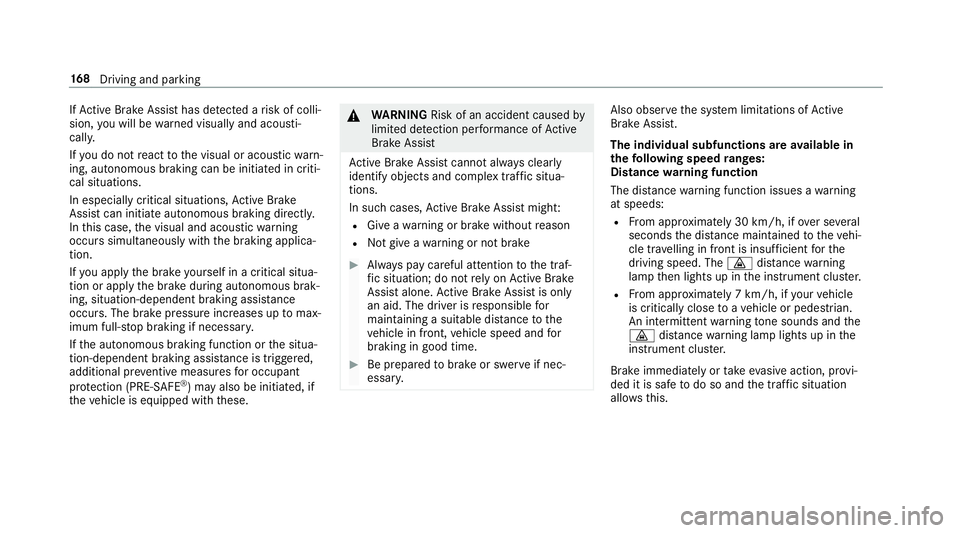
If
Ac tiveB rake Assi sthas de tected arisk of colli‐
sion ,you will be warned visuall yand acousti‐
cally.
If yo udon otreact tothev isual or acoustic warn‐
ing, autonomous brakin gcan be initiated in criti‐
cal situations.
In especially critical situations ,Activ eBrake
Assi stcan initia teautonomous brakin gdirect ly.
In this case, thev isual and acoustic warning
occur ssimultaneousl ywitht he braking applica‐
tion.
If yo ua ppl ythe brak eyourself in acritical situa‐
tio nora pplythe brak eduring autonomous brak‐
ing, situation-dependen tbraking assis tance
occu rs.T he brak epressur eincreases up tomax‐
imum full-s topb raking if necessar y.
If th ea utonomous braking function or thes itua‐
tion-dependen tbraking assis tance is trig gered,
additional pr eventiv em easu resf or occup ant
pr otection (PRE-SAFE ®
)m ayalso be initiated, if
th ev ehicle is equipped wit hthese. &
WARNING Risk of an accident caused by
limited de tection per form anc eofA ctive
Brak eAssist
Ac tiveB rake Assi stcanno talway sc lear ly
identify object sand comple xtraf fics itua‐
tions.
In su chcases, ActiveB rake Assi stmight:
R Giveaw arning or brak ewithout reason
R Notgiveaw arning or no tbrake #
Alw aysp aycareful attention tothet raf‐
fi cs ituation; do no trely on ActiveB rake
Assi stalone. ActiveB rake Assi stis only
an aid. The driver is responsible for
maintaining asuita ble dis tance tothe
ve hicle in front, vehicle speed and for
braking in good time. #
Be prepared tobrak eors werveifn ec‐
essar y. Als
oo bserve thes ysteml imitations of Active
Brak eAssist.
The individua lsubfunctions ar eavailable in
th ef ollowing speed ranges:
Distance warning function
The dis tance warning function issues awarning
at speeds:
R From appr oximatel y30k m/h, if overseveral
seconds thed ista nce maintained tothev ehi‐
cle tra velling in front is insuf ficient fort he
driving speed. The ·distance warning
lam pthen lights up in thei nstrument clus ter.
R From appr oximatel y7km/h, if your vehicle
is criticall yclose toav ehicle or pedestrian.
An intermittent warning tone sounds and the
· distance warning lam plight supint he
instrument clus ter.
Brak eimmediately or take evasiv eaction ,provi‐
ded it is saf etodosoa ndthet raffic situation
allo wsthis. 16 8
Driving and pa rking
Page 174 of 521

R
Can assis tduring swervin gand stra ightening
of thev ehicle.
R Can react from aspee dofa pproximately
20 km/h up toas pee dofa pproximately
70 km/h.
Yo uc an pr eventthea ssis tance at an ytime by
activel ysteering. &
WARNING Risk of an accident despi te
Evasiv eSteering Assist
Evasiv eSteering Assis tcann otalw aysc learly
identify objects and comple xtraffic situa‐
tions.
In addition ,the steering suppor tofEvasive
St eering Assis tisgenerallyn otsufficien tto
av oid acollision.
In suc hcases Evasiv eSteering Assis tcan:
R giveanu nnecessar ywarning or pr ovide
assis tance
R notg iveaw arning or no tprovide assis‐
ta nce #
Alw aysp aycareful attention tothet raf‐
fi cs ituation; do no trely on Evasive
St eering Assis talone. #
Beready tobrak eand take evasive
action ,ifnecessar y. #
Preve ntthea ssis tance byactivel ysteer‐
ing in non-critical driving situations. #
Driv eatana ppropriat espeed if pedes‐
trians ar eclose tothep athofy ourvehi‐
cle. Also obser
vethes ysteml imitations of Evasive
St eering Assist.
Sy stem limitations
The sy stem ma ybeimpaired or ma ynotfunction
in thef ollowing situations:
R In sno w,rain, fog, heavy spr ay,ift hereis
gl are, in direct sunlight or in greatlyvarying
light conditions.
R Ifth es ensor saredirty ,miste du p, damaged
or co vered. R
Ifth es ensor smalfunction due to otherradar
source inter fere nce, fore xamp lestro ng radar
re flections in multi-s toreyc ar par ks.
R Ifal oss of tyr epressur eorad efectivetyre
has been de tected and displ ayed.
The sy stem ma ynotreact cor rectly:
R In compl extraf fics ituations whe reobjects
cannot alwaysbec learly identified.
R Topedestrians or vehicles if they mo ve
qu ickl yintot he sensor de tection range.
R Topedestrians who ar ehidden by other
objects.
R Ifth et ypical outline of apedestrian cann ot
be distinguished from theb ackg round.
R Ifap edestrian is no trecognised as such, e.g.
due tospecial clo thing or other objects.
R On bends wit hatightradius. Driving and parking
171
Page 175 of 521

Setting
Activ eB rake Assi st Multimedia sy
stem:
, Vehicle .
k Assistance .
Active
Brak eAssist
Ve hicles without Drivin gAssistanc epack‐
age: The settings can be made af ters tarti ngthe
ve hicle.
Ve hicles with Drivin gAssistanc epacka ge:
The setting scan be made when thei gnition is
switched on.
% It is recommended that youa lway sl ea ve
Ac tiveB rake Assi stswitched on.
Select one of thef ollowing settings: #
Early :your selection is retained when the
ve hicle is next star ted. #
Medium :your selection is retained when the
ve hicle is next star ted. #
Late:y our selection is retained when the
ve hicle is next star ted. #
Off:
The dis tance warning function and thea uton‐
omous braking function ar edeactivated. Ve
hicles without Drivin gAssistanc epack‐
age: when thev ehicle is next star ted, the
mediu msetting is auto matically selected.
Ve hicles with Drivin gAssistanc epack‐
age: Evasi veSteering Assis tisnotavailable.
When thei gnition is next star ted, them iddle
setting is selected automaticall yand Evasive
St eering Assis tisavailable.
% When ActiveB rake Assi stis deactivated, the
æ symbol appears inthea ssis tance
graphi cinthe multifunction displa y. Ad
aptiv eBrake Lights function Ad
aptiv eBrake Lights warnfollowing traf ficinan
emergency braking situation:
R Byflashin gbrake lamps
R By activatin gthe hazard warning lights
If th ev ehicle is braked sharpl yfroms peeds
abo ve50 km/h, theb rake lamps flash rapidly.
This pr ovides traf fict rave lling behin dyou wit han
eve nm oren oticeable warning. If
th ev ehicle is tra velling at speeds of mor ethan
70 km/h at theb eginnin gofthe brak eapplica‐
tion ,the hazar dwarning light sswitc hono nce
th ev ehicle is stationar y.When pulling away
again, theh azar dwarning light sswitc hoffauto‐
maticall yatapproximatel y10k m/h .You can
also switc hofftheh azar dwarning light susing
th eh azar dwarning button. Cruise control and limiter
Fu
nction of cruise control
Cruise cont rola ccelerates and brakes thev ehi‐
cle automaticall yinorder tomaintain aprevi‐
ous lystored speed.
If yo ua ccelerat etoovertake, fore xamp le,the
st ored speed is no tdele ted. If your emo veyour
fo ot from thea ccelerator pedal af tero vertaking,
cruise control will resume speed regulation back
to thes tore ds peed.
Cruise contro lisoperated using thec orrespond‐
ing steering wheel buttons. Youc an stor ea ny
ro ad spee dabove 20 km/h.
If yo uf ail toadap tyour driving style, cruise con‐
trol can neither reduce ther isk of an accident 17 2
Driving and pa rking